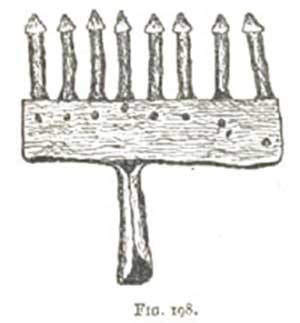The Chase and Capture of Wild Animals in Ancient Ireland
From A Smaller Social History of Ancient Ireland 1906
« previous page | contents | start of chapter | next page »
CHAPTER XXV....continued
6. Chase and Capture of Wild Animals.
Some wild animals were chased for sport, some for food, and some merely to extirpate them as being noxious: but it will be convenient to include all here in connexion with sports and pastimes. Everywhere in our literature we meet with notices of hunting, and of various other methods by which wild animals were taken. The hunters led the chase chiefly on foot, with different breeds of hunting-dogs, according to the animals to be chased. The principal kinds of game were deer, wild pigs, badgers, otters, and wolves; and hares and foxes were hunted with beagles for pure amusement. Pig-hunting was a favourite sport.
For the larger and more dangerous game, such as wild boars, wolves, and deer, the hunters employed wolfhounds and other breeds of large dogs; and in the romantic literature we have many a passage describing the dangers of the chase, and the courage, skill, and swiftness of hunters and hounds. The Tales also reflect the immense delight those observant and nature-loving people took in the chase and all its joyous accompaniments.
Most of the details of the manner of trapping deer we learn from the Book of Aicill. They were caught in a deep pit or pitfall, with a trap, and a bir or spear fixed firmly in a wooden stock in the bottom, point upwards; the whole gin concealed by a brathlang or light covering of sods and brambles. Wild hogs, wolves, and other animals were also caught in traps. Wooden traps for otters are now often found in bogs, with valves, springs, and triggers. The animal, while attempting to force its way through, was caught and held by the edge of the door or valve.
There were traps and nets of several kinds to catch birds. The word sás [sauce], which means an engine or gin of any kind, is applied to a bird-trap. A basket-shaped bird-crib, such as is used by boys at the present day, was called cliabhán [cleevaun], which is also the word for a child's cradle: a diminutive of cliabh [cleeve], a basket. Birds were also caught, as they are still in the Orkneys and Hebrides, by men let down in baskets with ropes over the cliffs round the coasts. Bird-catching was considered of such importance that special laws were laid down to regulate it—"bird-net laws," as they were called.
Fish as an important article of food has been already spoken of. The general Irish word for a fish is iasc [eesk], cognate with Latin piscis and English fish. The people fished with the net and with hook and line, both in the sea and in lakes and rivers. Net-fishing came under the cognisance of the law; it is mentioned in the Senchus Mór; and it appears from the gloss that a fishing-net was called cochull and lin [leen], both words in use still. Both salmon and eels were often caught with trident spears, or with spears of more than three prongs: and sometimes people followed the primitive plan of transfixing large fish with a single-point spear. Salmon-fishing was the most important of all, and it is oftenest mentioned in the old writings. A salmon is designated by several Irish terms; but bradán is now the general name.
FIG. 198. Iron-pronged Fishing spear now in Nat. Mus., Dub. (Drawn from the original).
Fishing-weirs on rivers were very common. A man who had land adjoining a stream had the right to construct a weir for his own use: but according to law, he could not dam the stream more than one-third across, so that the fish might have freedom to pass up or down to the weirs belonging to others.

